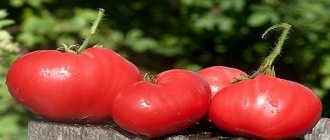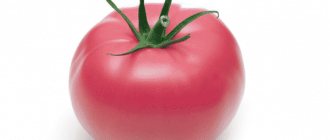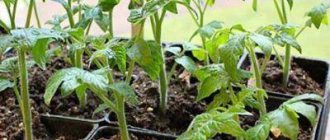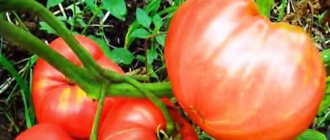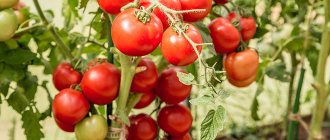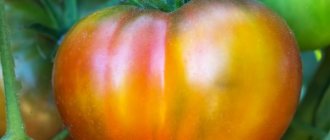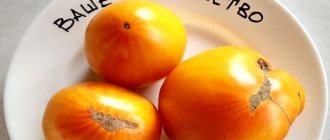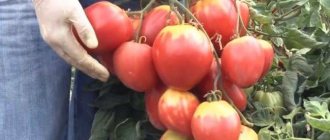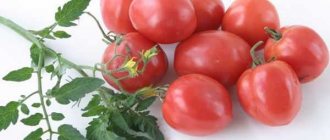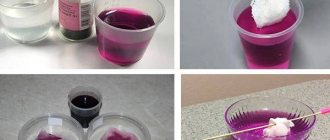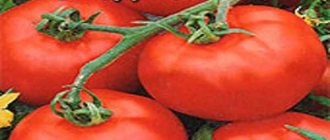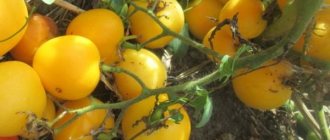The Novichok tomato, the description and characteristics of which are presented in this article, has good yield and excellent taste. Therefore, gardeners and farmers who cannot choose a specific variety can safely choose it for cultivation.
The tomato variety Novichok has long proven itself to be the best and is very popular, as it was bred by breeders for universal cultivation.
Important! In the southern regions of Russia, the Novichok tomato can be grown in open ground. In the climatic conditions of central Russia and Siberia, it is better to grow in greenhouses and film shelters.
Characteristics and description of the variety
Tomato Novichok is a variety that was bred by domestic breeders in the Volgograd region and registered in the State Register in 1986.
- Mid-early variety. The first tomatoes ripen 110-125 after germination.
- Determinate, the growth of the bush is limited by the flower raceme. It usually grows to 50-80 cm in height.
- Medium-leafed, medium-sized leaves of bright green color.
- The bushes must be tied to supports (trellises, pegs).
- To obtain a bountiful harvest, it is necessary to constantly remove all stepsons. They are carefully pinched, leaving a stump of 5-7 mm so as not to damage the main stem.
- The first brush is formed after 5-7 leaves. Subsequent ones are formed every 1-2 leaves. 6-7 identical tomatoes develop on one brush.
Important! The tomato forms a small number of stepsons and only at the bottom of the stem.
- Productivity is high - up to 4.7-5.5 kg per 1 sq. m landings. About 2 kg of tomatoes are usually harvested from 1 bush.
- Resistant to cold and drought. Thanks to these qualities, the variety can be grown in all corners of Russia in open ground, in a greenhouse and under film cover.
- It is unpretentious in care and resistant to nightshade diseases.
Important! Tomatoes retain all the qualities of the variety when seeds are prepared independently.
Characteristics of tomato Novichok
Features of the Novichok tomato include the relative unpretentiousness of the plant when grown, resistance to diseases, as well as a wide range of applications.
Tomato yield Novichok
On average, up to 2 kg of mature harvest is harvested from each bush. On every 1 m2 it is allowed to plant up to 7 bushes; as a result, from the same area of planting of tomatoes of the Novichok pink variety, from 6 to 14 kg of crop is harvested. If all agrotechnical recommendations are followed, the variety can exhibit higher productivity.
Area of application of fruits
Pink Novichok tomatoes are characterized by versatility in use. Due to their relatively small dimensions, tomatoes can be used for pickling and pickling. The fruits remain intact even after being treated with boiling water when preparing the marinade. Tomatoes are also consumed fresh; they are used to prepare salads and other dishes.
Important! In order to preserve fresh, ripe fruits for a long time, it is recommended to wither them.
The variety is recommended for cultivation on an industrial scale. This is due to various factors, including the simultaneous ripening of the crop.
Resistance to diseases and pests
The variety is resistant to major diseases that affect nightshade crops. The resistance of Novichok pink can be significantly reduced if the technology for growing the variety is not followed.
Among pests, the Colorado potato beetle can cause the greatest damage to Novichok rose plantations. Bushes are also affected by spider mites and slugs.
Advantages and disadvantages of the variety
The main positive properties of the variety include:
- low growth of bushes with a small number of stepsons, which greatly simplifies the care of plantings;
- stable and high productivity;
- versatility of fruits;
- unpretentiousness and ease of care;
- mid-early ripening, simultaneous ripening of tomatoes;
- possibility of growing without tying;
- high shelf life, ability to be transported over long distances while maintaining marketability and taste;
- high frost resistance and winter hardiness, which allows you to grow Novichok pink in various regions of Russia;
- the ability of seeds to carry all the varietal characteristics and properties of the mother plant.
Over the years of study, no deficiencies were found in the tomato variety in question. All the positive aspects of Novichok pink appear exclusively when it is cultivated in accordance with technology.
Fruit characteristics
- The fruits are red.
- The shape is oval, ovoid.
- On average they weigh 85-105 g.
- Resistant to overripening and cracking.
- The pulp is dense, fleshy.
- The skin is dense, even, smooth.
- Tasty, slightly sour.
- The fruits have 3-5 seed chambers.
- They ripen at the same time, making harvesting easier.
- Keeps fresh for a long time.
- They have good shelf life and resistance to transportation over long distances.
Newbie pink tomato description
Pink tomatoes are the most attractive and appetizing. The Novichok pink variety has many advantages and virtually no disadvantages.
Description of the variety
- It can be grown in open ground or a greenhouse;
- The tomato bush is not tall and stepsons are formed in small quantities in the lower part of the plant;
- He is not afraid of extreme heat or cold;
- Drought resistant;
- Resistant to diseases and pests;
- Does not require weekly stepsoning;
- Gives a plentiful and friendly harvest;
- After harvesting, tomatoes can be stored for up to several weeks without refrigeration, they can be transported over long distances, this does not affect the taste and presentation;
- The fruits are suitable for pickling, pickling, and other preparations for the winter. Ketchup made from tomatoes of this variety is especially tasty;
- This variety is not a hybrid, you can get your own seeds from the fruits and plant them next year, the harvest will not be less, as is the case with hybrid seeds.
Photo
Look at the photos of the Novichok tomato , which show many of the characteristics of the variety
Productivity
Novichok fruits are harvested as they ripen. Not only red and pink fruits are harvested, but also unripe ones with an orange color. Tomatoes of this variety will delight any vegetable grower with the friendly yield of the harvest. Depending on the planting scheme, you can get about 12 kg of smooth cream per square meter of area. And from a bush - 2 kg or more. Tomatoes will last longer if picked in the morning and immediately placed in a box in a single layer with the stems facing up.
Novichok tomatoes can be used both for salads and for making sauces and ketchups. But most of all this variety is suitable for preservation.
The yield of Novichok tomato is up to 2 kg per bush
If you really want the fruits to ripen earlier, you can use a sharp knife to make a through slit of about 5 cm on the stem in the area of the root collar and insert a wooden toothpick or other wooden pin with a diameter of 0.5 cm into it.
Advantages and disadvantages
Tomato Novichok pink , like red, has the same advantages:
- Fast and simultaneous ripening of fruits.
- Stable and reliable yield.
- Easy to care for.
- Resistance to diseases is inherent in this culture.
- Long shelf life of fresh tomatoes.
- Resistance to transportation.
- Versatility.
- They practically do not overripe and do not crack.
Flaws
The Novichok variety has no obvious disadvantages. However, some gardeners consider the smooth ripening of fruits not an advantage, but rather a disadvantage, since they want more extended fruiting.
Pest and disease control
To treat diseases of Novichok tomatoes, appropriate insecticides or folk remedies are most often used. Plantings should be regularly inspected for the presence of the first symptoms, since the disease can be cured more quickly in the early stages of its development.
In greenhouse conditions, pink Novichok tomatoes are most often affected by greenhouse whitefly, against which the drug Confidor is used. To remove spider mites or slugs, plants are washed with soapy water, and the plantings are also dusted with wood ash. To improve the effect, add 1 tsp per 1 m2 of soil. red pepper powder.
To prevent the appearance of Colorado potato beetles, it is recommended to plant dill along the perimeter of the variety’s plantings. Garlic infusion or tobacco dust reliably protects tomato plants from aphids.
To better familiarize yourself with the variety, it is recommended to watch the video:
Features of cultivation
Seeds are sown 60-65 days before planting in a permanent place. The time for sowing seeds for seedlings depends on where they will be planted in the future:
- For open ground – mid-March.
- For a greenhouse without heating - late February - early March.
It is possible to grow the Novichok tomato variety without seedlings only in the southernmost regions. Seeds are sown in holes 2–2.5 cm deep in a checkerboard pattern according to the scheme: 4–5 bushes per 1 square meter. This procedure is carried out when the soil warms up to at least 15°C. For example, in the Astrakhan or southern Volgograd region, sowing can be done as early as early May. Then the tomatoes will ripen by the beginning of autumn.
Most often, Novichok tomatoes, like most varieties, are grown through seedlings, which can be transplanted into open ground in the southern regions in the third decade of May. Seeds are sown 60 days before planting in a permanent place, approximately March 20. In the middle zone and Moscow region it is possible - at the end of March (7-10 days later).
The prepared seeds are buried 1.5 cm into the soil at intervals of 2.5–3 cm from each other. After 2-3 true leaves appear, they are picked into larger pots, maintaining a distance between shoots of 6–7 cm. When picking, you need to pinch the tip of the main root. The seedlings are transplanted into the greenhouse when the soil temperature warms up to 15-17 degrees according to the scheme: 1 sq. m 4-5 bushes.
More information about growing tomatoes is described in the article: Technology of growing tomatoes. Secrets of planting and care.
You might be interested in: How to properly plant tomatoes in a greenhouse: bush formation diagram, care features, photos and videos
Useful information: How to properly tie tomatoes in open ground: the best methods, step-by-step photo and video instructions
Care
The most generous harvest occurs only with proper care. The Novichok variety is not considered capricious, but requires adherence to agricultural technology.
- Loosening, mulching and timely weed removal are considered fundamental principles. Without them, the soil will not be saturated with oxygen, and the plant will grow more slowly.
- Tomatoes love abundant, but not frequent watering. A bucket of water is poured under each bush 2-3 times a week. In rainy or damp weather, reduce watering.
- Fertilizing allows you to support the plant at the time of flowering and fruiting. It is carried out three times. The first time is 14 days after transplanting into the ground with a urea solution. The second and third are during the period of flowering and formation of tomatoes. You will need complex fertilizer Kemira Lux, 1 tablespoon of which is dissolved in 10 liters of water.
The plant is resistant to pests and diseases, and therefore does not require preventive measures.
Growing Novichok seedlings
Healthy, strong seedlings are the key to obtaining a good harvest in the future. Making mistakes when planting seeds and caring for plants at the initial stage always affects the final result, so you must approach the matter with full responsibility.
Take care to purchase high-quality planting material from a trusted manufacturer, pay attention to the expiration date, the integrity of the packaging, and whether preliminary disinfection has been carried out. Planting seeds in containers is carried out approximately a couple of months before moving them into open ground. To more accurately determine sowing dates, count from the expected time of the end of spring frosts in your region two months ago and proceed. If you have a heated greenhouse, you can move the deadlines a couple of weeks earlier.
Planting seeds involves their usual preliminary preparation:
- sorting, discarding spoiled, damaged, empty units;
- disinfection from pathogens of viral and fungal infections;
- soaking with active growth stimulants;
- germination.
To disinfect planting material, a 1% solution of potassium permanganate is suitable, where the seeds are dipped for 15-20 minutes. Some gardeners use a 0.5% solution of baking soda, aloe juice, diluted with water 1:1. Ready-made purchased drugs are also suitable, for example, Fitosporin, prepared according to the instructions.
Attention! It is not recommended to overexpose in manganese; if the disinfection time is increased, this may affect the germination of seeds.
No less attention should be paid to the soil in which the seedlings will be grown. Unpleasant surprises can await both those taken from your own plot and those purchased. Therefore, it is recommended to first perform:
- heating in the oven at a temperature of 180-200°C, 15 minutes is enough;
- in the microwave - a couple of minutes at a power of at least 850 W;
- washing the soil mixture with boiling water or potassium permanganate.
After disinfection, moisten the soil, leave for 12-24 hours, and then proceed to planting. To grow seedlings, you can buy special pots, containers, or use any convenient-shaped container, for example, plastic cups, boxes of dairy products. Fill them with soil two fingers below the sides, compact them lightly, make neat furrows about 1 cm deep in 4 cm increments.
The variety feels good both in open ground and in a greenhouse.
The swollen seeds that have hatched after germination are carefully laid out with tweezers every couple of centimeters to make it easier to remove weak plants later. The grains are sprinkled with earth on top, watering is done very carefully so as not to wash them to the surface. You can use a regular spray bottle.
Attention! Excessive moisture provokes the development of mold and rotting of seeds.
The containers are placed in a well-lit place, without drafts, at a favorable temperature of 22-25°C. The first shoots appear after 4-7 days. After a few more weeks, you should fertilize with natural organic fertilizers; purchased ready-made humic preparations and vermicompost are also good. As they grow, young tomatoes are planted in larger pots.
Diseases and pests
This variety is resistant to most diseases. But still, do not forget about preventive measures. Timely weeding of the soil, watering and temperature regimes, fertilizing and fertilizing the soil will help avoid most troubles. In greenhouses and greenhouses, the main scourge of tomatoes is the greenhouse whitefly, and this variety is no exception. They fight it with the help of the drug “Confidor”.
In open ground, slugs and spider mites are often annoying. The most effective way to deal with these parasites is a soap solution that is used to wash the affected areas of the plant. The slugs will go away when the soil is isolated, and to be sure, add hot pepper to the soil at the rate of 1 teaspoon per square meter. meter.
This variety is good for everyone, both in yield and disease resistance. Good luck to everyone and success in growing tomatoes. Good luck and good training!
| Mid-early | Mid-season | Super early |
| Torbay | Banana legs | Alpha |
| Golden King | Striped chocolate | Pink Impression |
| King London | Marshmallows in chocolate | Golden stream |
| Pink Bush | Rosemary | The Lazy Man's Miracle |
| Flamingo | Gina TST | Pickling miracle |
| Mystery of nature | Ox heart | Sanka |
| New Koenigsberg | Roma | Locomotive |
If you find an error, please select a piece of text and press Ctrl+Enter.
